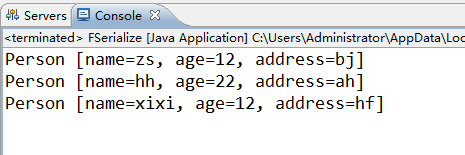线程及序列化
一、序列化与反序列化
把对象转换为字节序列的过程称为对象的序列化。
把字节序列恢复为对象的过程称为对象的反序列化。
对象的序列化主要有两种用途:
1) 把对象的字节序列永久地保存到硬盘上,通常存放在一个文件中;
2) 在网络上传送对象的字节序列。
序列化关键代码如下:
定义Person类实现序列化。重写toString方法,定义无参以及带参构造
定义类
public class MySerialize {
public static void main(String[] args) throws IOException {
OutputStream os=new FileOutputStream("save.bin");
ObjectOutputStream oos=new ObjectOutputStream(os);
List<Person> list=new ArrayList<Person>();
Person p1=new Person("zs",12,"bj");
Person p2=new Person("hh",22,"ah");
Person p3=new Person("xixi",12,"hf");
list.add(p1);
list.add(p2);
list.add(p3);
oos.writeObject(list);
System.out.println("序列化成功!!!");
}
}
反序列化关键代码如下:
public class FSerialize {
public static void main(String[] args) throws Exception {
InputStream is=new FileInputStream("save.bin");
ObjectInputStream ois=new ObjectInputStream(is);
List<Person> list=(List<Person>)ois.readObject();
for (Person person : list) {
System.out.println(person);
}
}
}
运行效果:

二、多线程两种实现方式
①继承Thread
②实现Runnable
1、继承Thread类的方法尽管被我列为一种多线程实现方式,但Thread本质上也是实现了Runnable接口的一个实例,它代表一个线程的实例,并且,启动线程的唯一方法就是通过Thread类的start()实例方法。start()方法是一个native方法,它将启动一个新线程,并执行run()方法。这种方式实现多线程很简单,通过自己的类直接extend Thread,并复写run()方法,就可以启动新线程并执行自己定义的run()方法。例如:
package cn.b.happy;
public class MyThread extends Thread{
@Override
public void run() {
System.out.println("我是新线程!");
}
}
MyThread t1=new MyThread();
System.out.println(Thread.currentThread().getName());
t1.start();
2、如果自己的类已经extends另一个类,就无法直接extends Thread,此时,必须实现一个Runnable接口,如下:
package cn.b.happy;
public class ImplThread implements Runnable{
@Override
public void run() {
Thread.currentThread().setName("子线程2");
System.out.println("子线程");
System.out.println("我是子线程");
}
}
ImplThread t2=new ImplThread();
//为了启动ImplThread,需要首先实例化一个Thread,并传入自己的t2实例:
Thread tt=new Thread(t2);
tt.run();
System.out.println(Thread.currentThread().getName());
}
三、
join():暂停某个线程
setDaemon()后台线程,又称守护线程,两个线程交替执行,当一个线程结束时,另一个线程也结束
Sleep():使线程休眠,单位是毫秒
关键代码:
package cn.c.happy;
public class SleepThread extends Thread{
@Override
public void run() {
Thread.currentThread().setName("子线程");
for (int i = 1; i <=5; i++) {
/*try {
//休眠
Thread.sleep(3000);
} catch (InterruptedException e) {
e.printStackTrace();
}*/
System.out.println("B"+i+"\t"+Thread.currentThread().getName());
}
}
}
package cn.c.happy;
public class Test {
public static void main(String[] args) throws InterruptedException {
SleepThread s1=new SleepThread();
s1.setDaemon(true);
s1.start();
//交替执行
for (int i = 1; i <=5; i++) {
if(i==3){
s1.join();// 调用join方法 执行完毕后再执行其他方法
}
System.out.println("A"+i+"\t"+Thread.currentThread().getName());
}
}
}





